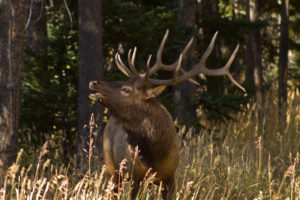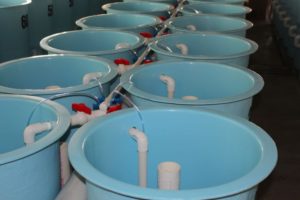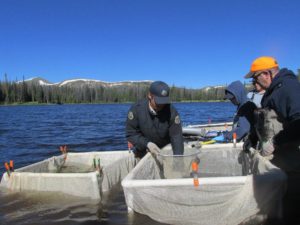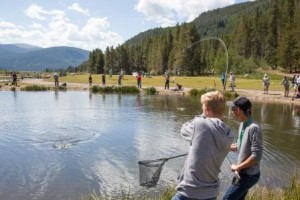By: Ryan McSparran, Anglers All Content Writer and Shop Sales Winter fly fishing opportunities abound for those brave enough to seize them. Here at Anglers All, we’re fortunate to have some of those opportunities right here in our backyard. Thanks to the help of TU and others, improvement projects continue to make the South Platte a better fishery every year. The South Platte from Littleton on to the north offers year-round excitement for trout, carp and the occasional smallmouth or walleye.
Tailwaters in Colorado and neighboring states like Wyoming offer excellent winter fishing and very light crowds when compared to the warmer months. For the adventurous souls willing to meet the challenges of cold weather, there are good things to be found.
I recently took a poll among the associates here at the shop. Most of them fish regularly throughout the winter. I asked for their best tips for staying warm on the water. How do they stay comfortable and have fun, even on the coldest days? Here’s what I heard.
“Get a big, tall glass,” manager Greg Garcia began with a grin on his face. “Shake up a nice martini until it’s really cold. Then stay inside and enjoy tying flies.”
In fact several of my conversations began that way. “Tie flies” and “Go tarpon fishing” were among the most popular opening answers. But as we drilled into the realities of winter fishing in Colorado, the tips were consistent across the board. In fact, the advice really boiled down into three points.
- Layer Properly
First and perhaps most obviously, it begins with what you’re wearing. But don’t just “dress in layers.” Be sure you’re layering property.
“No cotton!” several associates said emphatically. If you’re wearing cotton, that Gore-Tex won’t do you any good. Don’t wear cotton socks or anything else. Cotton absorbs moisture and holds it next to your skin.
“Wear a liner and wool sock combo,” Greg told me after we got back on track. “The liner will wick moisture into the second layer. Dry skin equals warmer feet.”
But be sure not to overdo it on the socks.
“Wearing too many socks that constrict your circulation will have the opposite effect,” warned Anglers All travel coordinator, Doug Garvey. “You want some dead air space to trap heat.”
For long underwear, consider synthetic base layers or merino wool. Over that you’ll wear insulation layers like fleece or down, depending on temperatures. Then finally, apply your outerwear, including waders and jacket.
“It’s important to wear something that’s breathable and wind proof,” said shop associate, Courtney Despos. “A good wading jacket is essential. It does more than protect you from flurries. It’s stops wind and allows moisture to escape.”
Convective heat loss from wind can take a serious toll. Having a jacket with a waterproof, breathable membrane will totally block wind while still allowing natural vapor to escape, keeping you dry from the inside.
- It’s the Little Things
For many seasoned anglers, a solid pair of waders and warm clothes may be obvious. But don’t overlook the little things. Losing heat in your head, neck and hands can quickly end your day.
 “I carry two pair of gloves,” Doug told me. “I fish with a half-finger glove or foldover mit. Then I keep a pair of full-finger gloves in an inside pocket. If my hands get cold, I can pull out those warm gloves.”
“I carry two pair of gloves,” Doug told me. “I fish with a half-finger glove or foldover mit. Then I keep a pair of full-finger gloves in an inside pocket. If my hands get cold, I can pull out those warm gloves.”
Several other associates said almost exactly the same thing. Fishing with a backup pair of gloves can extend your time and comfort on the water. Just as importantly, do whatever you can to keep your gloves dry.
“Pinch your barbs and have your hemostats in a spot that’s easy to grab,” Doug continued. “If you’re prepared, you can quickly release the fish with your net without submerging your hands.
Inside your gloves, your wader pockets or even your boots, you might consider bringing a few hand-warmers. Next, consider what you will need in terms of headwear.
“I like to bring two hats with me,” said shop associate, Ben Baxter. “I carry a warm beanie and a regular cap. If I feel myself getting too warm, I quickly take off the beanie. The last thing you want is for your head to get sweaty.”
Ben also suggested a wool Buff or neck gaiter. Keeping the back of your neck warm is something that’s easy to forget about until it’s cold. Being able to cover your neck and ears can make a tremendous difference.
- Drink Something Hot
When you’re properly layered and have all your bases covered, there’s not much left to do but get out there and enjoy the solitude of a winter day on the water! But when you get back to the truck or when it’s time to take a break, there’s nothing better than having something hot to drink.
“Don’t forget to bring your Yeti with some coffee or hot tea,” Ben concluded.
Doug echoed Ben’s remark. “A thermos of hot chili or soup will never taste better,” he said.
And of course, I couldn’t forget to pass along the one piece of advice that every one of these trout bums repeated.
“Don’t forget the whiskey!”*
Since 1969, Anglers All has provided anglers with with the best information and equipment no matter the year, the water conditions, or the species of fish. Based out of Littleton along the South Platte River, Anglers All works with Trout Unlimited on restoring the S. Platte back to a healthy fishery. Anglers All offers classes and clinics on fly tying and much more!
* Please note that whiskey does not make you warmer and instead can actually make you colder. Alcohol causes your blood vessels to dilate, moving warm blood closer to the surface of your skin, making you feel warmer temporarily. However, at the same time, those same veins pumping blood closer to the skin's surface cause you to lose core body heat .








 Daniel Galhardo, a soft-spoken 30-something who looks younger than his years, is credited with introducing tenkara to the American angler. On a trip to Japan in 2008, he wanted to fly-fish and discovered tenkara—and soon ditched his international banking ambitions to become a missionary for tenkara in America.
Daniel Galhardo, a soft-spoken 30-something who looks younger than his years, is credited with introducing tenkara to the American angler. On a trip to Japan in 2008, he wanted to fly-fish and discovered tenkara—and soon ditched his international banking ambitions to become a missionary for tenkara in America. In 2012, she and her then-husband started
In 2012, she and her then-husband started 

 watersheds to be at normal levels in order to flourish. Dissolved oxygen (DO) is fundamental to aquatic life. With higher levels of snowpack, there is more capability for dissolved oxygen in water due to higher water levels and colder temperatures. Cold water can hold more DO than warm water. Higher DO levels are achieved when water levels and flow rates are high and where the water is aerated in the rapids.
watersheds to be at normal levels in order to flourish. Dissolved oxygen (DO) is fundamental to aquatic life. With higher levels of snowpack, there is more capability for dissolved oxygen in water due to higher water levels and colder temperatures. Cold water can hold more DO than warm water. Higher DO levels are achieved when water levels and flow rates are high and where the water is aerated in the rapids. Current Status
Current Status CPW is the largest owner of dams in Colorado and oversees 19 hatcheries in the State, where it raises 90 million fish annually for stocking rivers and lakes, and with limited funds it says it is falling behind on dam and hatchery maintenance. As examples of rising costs since 2005 – the last time resident fishing license fees were increased – CPW points to some specific examples: leasing water for hatcheries has increased 344 percent; fish food has risen 92 percent; and the cost of a fisheries work boat has increased 24 percent. CPW personnel indicate that there have been some major investments out of their control such as information technology and new Statewide accounting systems. They also point to new wildlife challenges with which they’ve had to contend such as whirling disease and invasion of aquatic nuisance species that have imposed unexpected costs. Then, of course, costs such as those associated with personnel, health care, and utilities have consistently increased during this time span as well.
CPW is the largest owner of dams in Colorado and oversees 19 hatcheries in the State, where it raises 90 million fish annually for stocking rivers and lakes, and with limited funds it says it is falling behind on dam and hatchery maintenance. As examples of rising costs since 2005 – the last time resident fishing license fees were increased – CPW points to some specific examples: leasing water for hatcheries has increased 344 percent; fish food has risen 92 percent; and the cost of a fisheries work boat has increased 24 percent. CPW personnel indicate that there have been some major investments out of their control such as information technology and new Statewide accounting systems. They also point to new wildlife challenges with which they’ve had to contend such as whirling disease and invasion of aquatic nuisance species that have imposed unexpected costs. Then, of course, costs such as those associated with personnel, health care, and utilities have consistently increased during this time span as well. Regarding fishing licenses, the price increment in resident fishing licenses that has been bandied about most often at these meetings was a hike for adults from $26 to $50, almost a 100 percent increase. If such an increase was approved, CPW discussed whether or not it should be implemented in one year or, perhaps, in stages over a 4 to 5 year time span. Whatever price increase instituted, if any, should have a sound rationale if it’s going to receive legislative approval. CPW might look at the price increases that other states have adopted, or possibly the price increase could be based on some econometric modeling derived from results obtained in a “willingness to pay” survey. In addition to holding 18 public meetings this past summer, CPW send post cards to 3,000 randomly chosen resident license holders (half hunters, half anglers) to ask if they supported increasing license prices. CPW also gathered input from an online public comment form on its website regarding people’s willingness to pay more for a fishing/hunting license.
Regarding fishing licenses, the price increment in resident fishing licenses that has been bandied about most often at these meetings was a hike for adults from $26 to $50, almost a 100 percent increase. If such an increase was approved, CPW discussed whether or not it should be implemented in one year or, perhaps, in stages over a 4 to 5 year time span. Whatever price increase instituted, if any, should have a sound rationale if it’s going to receive legislative approval. CPW might look at the price increases that other states have adopted, or possibly the price increase could be based on some econometric modeling derived from results obtained in a “willingness to pay” survey. In addition to holding 18 public meetings this past summer, CPW send post cards to 3,000 randomly chosen resident license holders (half hunters, half anglers) to ask if they supported increasing license prices. CPW also gathered input from an online public comment form on its website regarding people’s willingness to pay more for a fishing/hunting license.

 What is your favorite activity or project that you have done with TU?
What is your favorite activity or project that you have done with TU?
